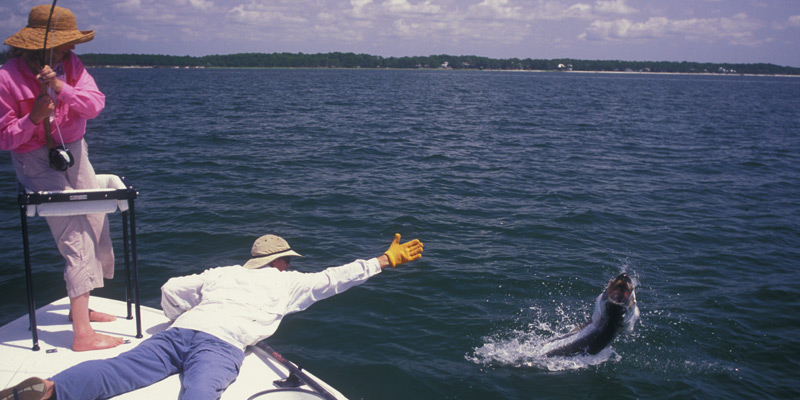A tarpon has a huge mouth. Think of it as a 2 gallon bucket. Your little fly is floating around in there. What you have to do is tighten up and hope your sharp hook grabs something in his mouth. When it does, you have to strip strike. That means you have to jerk with your non-rod hand by pulling on the line hard to set the hook while pointing the rod tip at the tarpon. If you lift your rod like you would when trout fishing you will almost always pull the fly out of the tarpon’s mouth. That is called tipping the rod. Your rod bends and there is not enough direct contact and strength to pull the hook deeply into the tarpon’s hard jaw. This reaction is very hard for trout fishermen. Trout fishermen have learned to set the hook by lifting the rod. It won’t work. You might get lucky but usually you don’t.
When the tarpon figures out he is hooked he goes crazy. They usually jump out of the water, sometimes ten feet in the air on the first jump. I’ve had that happen ten feet from the boat. That is something you will never forget. Then they take off fast jumping over and over. You will have line laying on the casting platform at your feet. You have to make sure it does not wrap around something like your toe for instance. Are you standing on your line? You hold your line out away from the rod so it doesn’t grab your reel. This is called clearing our line.
The fish is running away fast and you are in your backing in seconds. By the time your guide jumps down from the poling platform and starts the engine to chase down the fish you are 200 yards from your tarpon and he is still running and jumping. At this point you are overcome with excitement. There is nothing like it. Your heart is pumping, your brain is on overdrive and your body is weak. You can barely hear everyone else on the boat screaming out instructions and laughing. It’s you and this big fish battling it out. Your guide is happy, your fishing buddy or wife is happy and you are in panic mode
Most of the tarpon we fish for are between 75 and 140 pounds. Sometimes a 100 pound plus tarpon can take an hour or more to land. Fighting a fish that size is very strenuous work. That takes all the strength I have. I’m usually worn completely out in an hour. We have also hooked tarpon that would have taken longer than that to land. If they don’t jump during that first run you are in for a long battle. We have brought several tarpon to the boat. But after a few of those I began to realize that the long fight was not worth the effort. I started breaking them off on purpose. Now why would I do that?
For one thing you are out there wrestling around with this fish and you are missing the prime fishing time. The most exciting moment in fly fishing for tarpon is when they eat your fly. You watch them open that huge mouth and grab your small baitfish pattern.
The second most exciting moment is when you tighten up, set the hook and they jump. Third is watching them take off while stripping a couple of hundred yards of line and backing from your reel. Getting your fly line back into the guides of your rod is a good feeling. The boat is moving toward them and you finally accomplish that task. But most times they just take off again. That is when it becomes work.
Maybe I’m different from you. I’m satisfied with the eat, jump and first run. Then after a few minutes I’m ready to do that again. The sport is not for everyone. It is expensive and you can take a trip to Florida and be weathered out every day. But, when that magic moment arrives and you see a tarpon eat your fly, you feel like it was worth everything, the money and the time.
|





